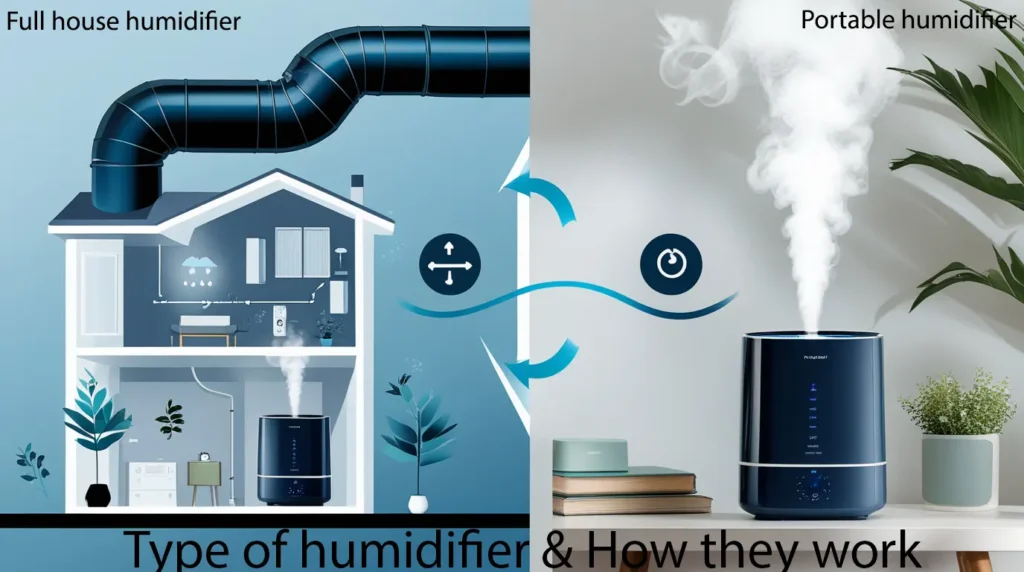Type of humidifier & How they work?
Humidifiers are made to increase the humidity of Homes, offices, small rooms, etc places. Humidity must be at a perfect level like 45/50% for home & office environments. More than 50% humidity or less than 50% humidity is harmful to our health. For higher humidity areas we used dehumidifiers because it maintains humidity by removing extra moisture from the air.
For low-humidity weather, we use a humidifier which can maintain the required humidity by increasing the humidity level in the air. Most of the time in summer low moisture issues don’t happen but if your home or commercial space has central AC then you might need a humidifier. The Humidity level becomes much lower in the winter season. That is why our skin & lips get dry in winter. In this blog, we will discuss about all types of humidifiers and how they work.
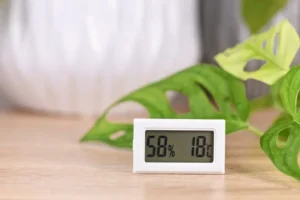
With simple tools like a hygrometer, you can see the humidity level of your house. If you don’t have one then by observing some syndrome you can confirm that the humidity level in your room is low. Due to low humidity while sleeping, you will face skin and mucous membranes, your mouth, lips and tung will get dry. which is very uncomfortable & you might wake up with dry skin and dry nose and throat & itchy eyes.
Regular humidifiers provide you with 1 to 4 /5 settings to increase the humidity in the room. It provides less control than a humidistat-controlled humidifier. I know some users who are facing problems like, even if they set the setting on 1, the humidity level gets increased more than the required level. Which is uncomfortable. This happens when the humidity requirement is very low. I suggest them to put water in the water tank while the humidifier is off. I suggest it, because when you put water on the tank and give space to pass the air on it then by neutral evaporation the moisture level can increase. It worked for two of my friends and for others it didn’t work. If you are facing these issues then you can try it, but the result depends on the moisture level, temperature & environment around you.
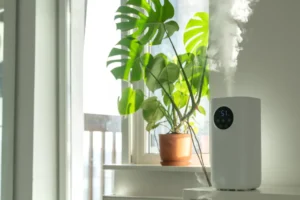
You will not face those issues if you use a humidistat-controlled humidifier. It has a hygrometer sensor. If you set a 50% humidity level on the humidifier, when it increases more than 50% then it will turn off and when it becomes less than 50% it starts automatically to maintain your required humidity level.
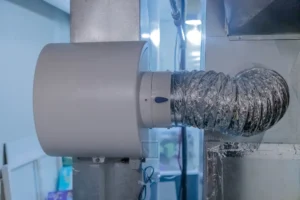
There are portable humidifiers and full-house system humidifiers that work with HVAC systems. If your house, office, pharmaceutical & industrial area has an HVAC system and you require a humidifier then you can use it with a supply duct. Unlike portable humidifiers, it provides humidity control over large spaces. A portable humidifier allows you to increase the moisture level for a single room. On the other hand with a whole-house humidifier, you can ingress every room’s moisture level. The best part is you can even control it with a thermostat display.
There are three types of whole-house humidifiers
- Steam
- Flow through
- Dram (Bypass)
Steam humidifier:
This type of humidifier increases moisture by electrically generated heat. In the water tank there is a heating coil which is connected by electrical cable. When you turn it on, the coil gets heated and it boils the water. After this moist air goes to the supply duct line and through this duct line it increases the required amount of moisture for your home or commercial space. There is a water supply line in the water tank. Due to electrical heat when the water evaporates, the water level decreases. To maintain proper availability, a water supply pipe line connects to the water tank. The controlling system is very easy and practical. You can easily control it with a thermostat. A place where the weather is very hot could be perfect. But there are some issues, which comes with it like higher electrical consumption, you need to clean the heating coil, placed in the water tank. After long use, it can be covered by the courts. Which will cause issues like less humidity and higher electricity consumption. When it happens, scrubbing it into vinegar will help you to clean it.
Drum (Bypass) Humidifier:
A whole is cut into the supply air duct where the humidifier will be mounted. A drum humidifier consists of an absorbent pad that rotates on a drum. The drum rotates through a pan of water causing the pad to soak up water. A flexible bypass duct is installed from the return air side of the system into the humidifier. During summer when humidity isn’t required the bypass duct has a shutoff damper that prevents air from passing over the humidifier. The home’s HVAC system fan forces dry air over the rotating drum. As the dry air passes over the moist pad rotating on the drum, the air picks up moisture through the process of evaporation. The moist humid air is then distributed throughout the home through the HVAC ductwork, increasing the indoor humidity levels. Electrical power to a transformer provides low-voltage operation of the humidistat and solenoid control valve. Some models come with a power cord that you plug into an outlet, saving you the extra step of wiring. There are options for manual or automated control of the humidity level. With automatic control, there may be an outside air sensor. Some controllers have a simple dial that you turn to indicate whether you want more or less humidity. Mounting is often recommended to be on the return air duct or wall-mounted. These humidifiers require regular maintenance, including cleaning the drum and changing the water pad or foam, to prevent mold and bacterial growth and to ensure optimal performance.
Flow through humidifier:
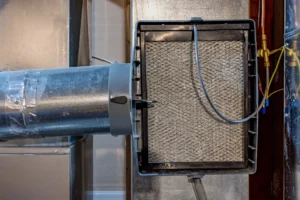
A flow-through type whole-house humidifier is also known as a bypass humidifier. Unlike the drum humidifier, there is no rotating drum or reservoir of standing water. A flow-through humidifier operates by allowing water to flow continuously over a humidification medium, typically a water panel or evaporator pad. Here’s how it works: A flow-through humidifier is mounted on the supply air plenum after the coiling coil or furnace. A small water tube will need to be tapped into a water pipe and then connected to the unit through a solenoid valve. A small drain line attached to the bottom of the humidifier allows for any condensate to be removed safely to a drain. If you have a cooling coil installed then there should already be a drain line that you can tap into. When the home’s heating or cooling system is running, a portion of the dry air from the HVAC system is diverted through the flow-through humidifier. The diverted air passes over the water-saturated pad. As it does so, it picks up moisture through the process of evaporation. The air, now with added moisture, is then distributed back into the home’s ventilation system and circulated throughout the entire house, effectively increasing the indoor humidity levels. The humidistat will control the operation of the humidifier and is completely programmable to the user’s liking. One of the advantages of flow-through humidifiers is that they use fresh water from the home’s supply, which can help reduce the risk of mold or bacterial growth associated with standing water.
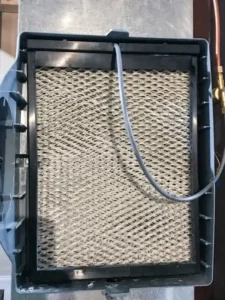
However, these systems do require regular maintenance, including replacing the water pad at regular intervals and cleaning the unit to ensure efficient operation and prevent potential issues with mold or mineral buildup.
Ultrasonic humidifier:
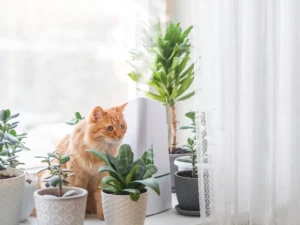
Ultrasonic humidifiers generate humidity by using ultrasound. It has almost no sound issues at all. In all types of humidifiers, this is the most quiet humidifier. The very high frequency generated by ultrasound breaks the water into droplets and comes out from the surfers. Compared to other types of humidifiers this is very efficient because it is not evaporating. It took 3 hours to make your room environment better. Ultrasonic humidifiers provide good service for small rooms. For commercial buildings and large areas humidity control doesn’t work properly. Ultrasonic humidifiers don’t have any filters, so make sure you are using clean water. This will ensure the air around you is clean.
Evaporative humidifier:
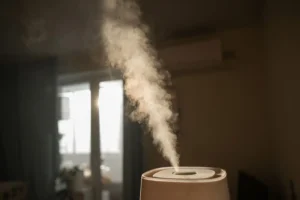
This kind of humidifier makes the neutral evaporation process faster to generate moisture. We all know if we put water on something, it generates moisture due to the natural evaporation process. There is a fan motor in evaporative humidifiers, because of this fan air flows at a high speed through a filter that is wet on water and moist air is released through the filter. This makes the evaporation process faster than the normal evaporation process. This kind of humidifier is suitable for medium to large homes and commercial spaces like offices. After a certain time of use, the filter needs to be changed, otherwise mold & bacteria issues can happen. It will affect the air quality of your home and can be the cause of sickness. Evaporator humidifiers are not harmful to your kids or pets and it is energy efficient also.
Impeller humidifier:
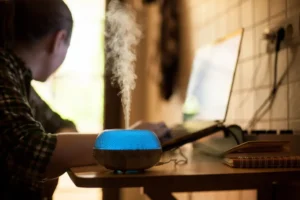
This humidifier works in a different process than others. There is a water chamber under the water tank, where all things are processed. First from the water tank, the water goes to the water chamber. This water wet a spinning disk placed in the water chamber. The spinning disk is filling the water outward due to centrifugal force. When this flung water hits the diffuser, it converts the water into moisture. The diffuser is designed to break the water into moisture. Through a fan, this moist air spreads all over the room and makes sure that your room air isn’t dry. Clean the disk weekly to avoid unhygienic air flow and when it comes to electricity consumption it is very energy efficient.
Steam vaporizer humidifier:
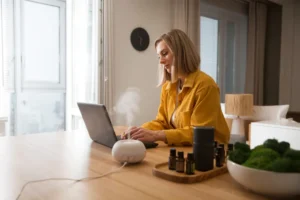
It works like an electric water heater. There is a heating coil in the steel chamber which generates moisture by boiling the water and spreading it all over the house. Some models used for medical usage like “VICKS” are used as diagnostic therapy devices. It can produce 212 degrees Fahrenheit temperature. It is built for short time usage like for medical relief not for room uses. But you can use it for extreme ice-cold areas. Although it is quieter than the Evaporator (Fan-based) humidifier but consumes more electricity. you need to clean the heating coil, placed in the water tank. After long use, it can be covered by the courts. Which will cause issues like less humidity and higher electricity consumption. When it happens, scrubbing it into vinegar will help you to clean it. Steam vaporizer humidifier is not safe for kids & pets, so be careful about it and it consume very high electricity.
Worm mist humidifier:
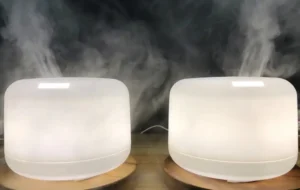
This humidifier is built for cold places. It works exactly like a Steam vaporizer humidifier. Both are the same, the only difference is heated moisture didn’t come out at a high temperature. It goes to a cooling chamber and cools down. in a Steam vaporizer humidifier moisture comes out at 212 degrees Fahrenheit but in a warm mist humidifier after moisture cools down in the cooling chamber it comes out at 80-90 degrees Fahrenheit.

